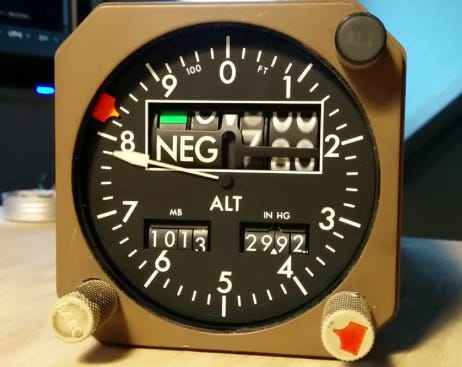Altitude Error: That Time I Should've Spoken Up
The one time I chose to keep my mouth shut was nearly the time I contributed to controlled flight into terrain.
I was in the left jump seat of a 767 descending into Germany after an 8-hour flight from Baltimore, MD. As the loadmaster for a military charter airline, I often found myself needing to sit in the cockpit when the cabin was fully occupied by soldiers. I was still new and not well-trained enough to realize that I should have been more confident and more willing to be an active voice in the flight deck.
All I know now is that I had the chance to correct an error that could have been a step in an accident sequence, and I didn’t speak up.
On descent, I heard ATC assign us an altitude and give us a new altimeter setting. I noticed the pilots acknowledged the altitude assignment but did not set the altimeter. I understood the importance of the altimeter setting, but I assumed this experienced pilot had a reason for not adjusting it—one that I, as a rookie loadmaster, wasn't aware of. It was a busy flight deck and I just didn’t have the knowledge or confidence to say anything.
What’s this “Altimeter Setting” thing?
Altimeters determine an aircraft’s altitude by sensing external air pressure. Since air pressure varies by location and weather, the altimeter must be calibrated with the current pressure to ensure accurate altitude readings.
Air traffic control provides these revised pressure measurements to pilots as an altimeter setting so that airplanes don’t hit the ground or other airplanes.

The sun had just come up but we were descending through clouds most of the way down, so the view outside was just white. We had no visual reference and certainly no view of the pretty German landscape that I enjoyed.
As we leveled off at 5,000 feet, I heard the controller tell us that we needed to be at 5,000. Our Captain got on the radio and confirmed the number, with no additional action taken because we had just gotten to that altitude. Or so we thought. Then the controller repeated more urgently, “Reach 123, climb and maintain 5,000!” and both pilots raised their hands from the controls and looked around, trying to figure out the problem, since the altimeter showed we were at 5,000 feet.
“Altimeter setting,” I said into my mic, but I wasn’t sure if my intercom was on, or if they heard me, or if they misinterpreted my comment as a question rather than a correction.
The Captain asked the controller what the altimeter setting was, then spun the dial to fix it accordingly. As he did so, the displayed altitude fell, fast, showing that we were actually at 3,800 feet. Jesus. We then climbed to the corrected height pretty quickly.
After landing, the pilots became defensive in conversation and were quick to blame the controller. She seemed overwhelmed, they said, along with a vague implication that “she” couldn’t handle the job.
On the crew bus, the Captain wanted to get our stories in sync, knowing they needed to write a report on it. So, there’s a report out there somewhere.
They said they never heard her give an altimeter setting. The Captain asked if I agreed. I don’t remember whether I said, “I thought I heard it,” or if I played dumb to avoid debating with a crew I’d be stuck with for the remainder of this trip. But, I knew that any report I wrote or anything that was asked of me once I got back to HQ would hear the full, accurate story.

Regardless, “Today-Phil” wouldn’t handle it the same way that “Mid-20s Phil” did. I should have spoken up on the altimeter setting sooner, and I should have spoken up in defense of the female controller. I sometimes wish I could slap my younger self.
My big lesson? If you are in the flight deck, you’re never just an observer. You’re an active member of the crew. That means listening to radio calls, watching inputs, helping spot traffic in sight, and maintaining overall situational awareness. I’d later be in other situations where I did speak up. I’ll tell those stories another time.
Every aviation accident happens for a series of reasons that lead to the crash. Equally, along that path are opportunities to prevent that sequence from continuing.
As for the flight in question, I don’t know if we came close to any mountains, and I have no reason to believe that we were in any imminent danger, but Germany isn’t exactly flat. A 1,200-foot discrepancy that low to the ground is certainly enough to risk a major problem, and even though I spotted the mistake several minutes before anyone else in the flight deck did, I kept my mouth shut, like a dummy. My silence could have led to the last words on a Cockpit Voice Recorder reciting “Say, what’s a mountain goat doing way up here in a cloud bank?”
This story is true to the best of my recollection. I did intentionally modify two details of this story for security reasons, but those details did not result in any embellishment.
If you have a question about aviation, my career, or a story request, please email me at phildernerjr@gmail.com.
Disclaimer: The views expressed in this article are solely my own and do not represent the positions of my employer or any affiliated organizations. This content is for informational purposes only and is not intended as professional advice.

When I’m right seat, I always adjust my altimeter baro myself, after the ATC call, as a signal and to get at least one altimeter correct.
Wow.
I tell folks, especially if they are pilots, when sitting in the right, seat that they are flight crew. Speak up. I won’t take it personally.